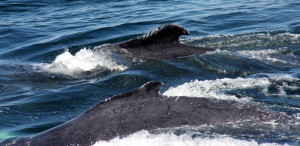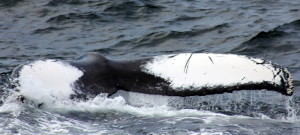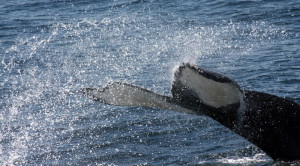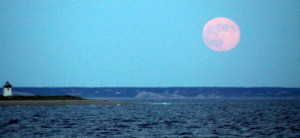Naturalist Notebook – June 30 to July 6
June 30 proved to be a perfect day on the water despite a breezy and bumpy start to the morning. While close to shore, whale watchers enjoyed the company of three baleen species: humpbacks, minkes and fin whales. Decreasing winds and flattening seas permitted unobstructed views of the second largest whale in the world-the fin whale. Despite their tendency to travel quickly (they are named the ‘greyhounds of the sea’ for a reason) this ~70 foot whale was moving slowly along side the boat, allowing passengers to appreciate the streamlined nature of the animal.
In the afternoon over a hundred conservation oriented philanthropists (supporters of the the Provincetown Centre for Coastal Studies a local non-profit research and rescue institution) boarded the whale watch boat in hopes of seeing some of the animals they hope to help save. And whales they did see! Among the 4 humpback whales encountered, were Eruption and Infinity, two adult humpbacks that have faithfully visited these cold Cape Cod waters time and time again. Fin and minke whales also made an apperance toward the end of the trip.
The Dolphin Fleet crew had their work cut-out for them on July 1 as they traveled from one edge of Stellwagen Bank to the next in search of whales. After having no luck at the usual feeding spots (and being the first boat out), the captain decided to move east. Suddenly, a blow was seen, which was shortly followed by others. As the boat approach the blows a large circle of light green water appeared and the wide open jaws of a baleen whale were seen almost flying through the light green water. It became almost immediately clear that this was Seal, an adult male humpback whale who frequently forages on Stellwagen Bank. Another humpback named Spike was later seen going on long fluking dives and several minke whales were spotted too!
Traveling further from shore on July 2 brought tremendous luck as large numbers of humpback and minke whales were observed, along with a couple of fin whales. During the start of the day the whales appeared to be in search of prey as their movements were somewhat erratic and difficult to predict (random travel such as this usually signals that whales are looking for or are following prey). Many humpbacks , such as Splice, were going on deep dives as they were raising their flukes high out of the water. Although we can never really know for sure, all signs pointed to the fact that these whales were feeding, likely consuming dense schools of fish located deep in the water column. In the afternoon two mother and calf pairs (Scylla and calf, Diablo and calf) were observed. Most notable was the calf of Diablo who was incredibly vocal, making lots of gurgling sounds and fun unusual noises that were heard by all.
It was a beautiful day to be out on the water on June 3 with warm air, a cool breeze and calming seas. Several well known humpback whales were spotted, including Putter an adult male born in 1993, Loon and Entropy who are both adult females first seen in 1995 and 1997. In the afternoon, Scylla and her calf were observed. The calf was seen nursing but this subsurface behaviour quickly changed into acrobatic displays of breaching and flipper slapping. And just before the trip was over, a humpback began kick feeding (slapping its flukes on the surface of the water to disorient the school of fish below) and then surfacing with a wide open mouth that was full of fish.
July 4 began with bright skies and a hazy horizon. A preponderance of minke whales were sighted throughout the day with a few humpback whales as well. Not too far from shore, off the backside of Cape Cod, a 27 year old female humpback named Apostrophe was sighted along with Dyad a female first seen in 1987 and a whale of unknown sex born in 2007 named Longboard. Although it may seem trivial, knowing the age of the humpbacks who visit Stellwagen Bank is incredibly important for understanding their population dynamics. For example, the longevity of the species is currently unknown and without age information researchers will not be able to answer very basic questions such as how long the whales live. This is among one of the many reasons why the Dolphin Fleet conducts photo-ID work on every whale watch, because the only way to accurately age a humpback is to photo-document it during its first year of life.
Longboard was certainly the most active of all the humpbacks seen. This whale conducted every active behaviour imaginable, with spinning breaches, chin breaches, lob tailing, and flipper slapping! Although it is unknown why humpbacks display such active behaviours, some suggest that it may be a form of play, communication or simply a method of exfoliation.
The sun began setting and skies became a bright mix of orange, yellow and pink as the whale watch boat made its way back to Provincetown in time to watch the fireworks.
Something was definitely in the air on July 5. According to some naturalists, this was the most active whale day they had ever experienced. The day began with close looks at a fin back whale off Race Point, followed by several humpback whales. Among those identified were Dyad, Columbia, Hancock, Dusky and calf and Scylla and calf. Scylla’s calf put on an incredible show with spinning breaches, flipper slapping, tail lobbing and chin breaching. It was remarkable to witness such an array of active and energetically expensive behaviours from such a young animal.
The frequency of these active behaviours only increased as the day progressed. During our afternoon trips, the Dolphin VII again spotted Scylla and her calf. Upon first sight, the pair were swimming side-by-side, which was then followed by high fluking dives. Thinking that Scylla’s calf was likely tuckered out from the morning, it was completely unexpected when both Scylla and her calf breached completely out of the water next to the boat. What was perhaps even more surprising was that the pair continued to display active behaviours for the next hour!
July 6 saw several changes. Although many of the same individuals were sighted over the course of the day, several ‘new’ but well known whales were observed as well. One of the most notable sightings was Isthmus and Orbit. Isthmus is the daughter of Orbit, born in 1986. Orbit was first seen in 1979 and has had 7 calves that we know of. Thanks to the strong site fidelity of humpback whales, we are often lucky enough to see calves return to Stellwagen Bank a year later as juveniles and eventually as adults. During the afternoon, we sighted Boomerang and her calf and got close looks at Boomerang’s calf breaching out of the water. With any luck we will encounter Boomerang’s calf next year and will assign it a name based on a unique marking found on the underside of the whale’s tail.
As our day concluded while reaching long point, we couldn’t help but notice the bright pink moon that began raising from the sea.


















